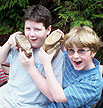

Mammoths and
Mastodons
Paleoindians
Extinctions
Range
Description
Credits
Links
Home
What is the Link Between Mammoths and People?
Mammoth bones and Paleoindian artifacts have often been found together in North America. Paleoindians were the very first arrivals into the Americas. They are considered to have crossed Beringia when sea levels were much lower, exposing a vast land bridge between Siberia and Alaska, at approximately 12,000 years ago. It is believed that Paleoindians hunted megafauna across Beringia and eventually entered North America.
Paleoindian hunter-gatherers are named for their hunting of big game, such as mammoths and mastodons, and foraging for other food resources. Paleoindians are associated with Clovis artifacts, usually referring to the style of stone tools they had made and used. A Clovis point (Fluted point tradition) is a biface that has been worked on both sides, is large and leaf-shaped, and has a large flake (or flute) on each face, to allow for hafting onto a spear shaft. A Clovis site near to British Columbia is the East Wenatchee site in Washington State n the Columbia River, east of the Cascade Range. “Several Clovis sites are 'kill sites' where fluted points were found in direct association with the bones of the ice age elephant, the mammoth” (Carlson and Della Bona 1996: 7).
One mammoth would have provided much meat and fur, clearly prized by Paleoindians.
“By about 11,600 years ago, the great biomass of the herd herbivores furnished bands of Clovis hunters and gatherers a lucrative enticement, with adult mammoths weighing as much as 13,000 kg, 30-40% usable meat and by-products. It is not possible yet to discern if mammoth hunting was a seasonal or year-round activity, but individual animals supplied sufficient meat for two weeks during the warm seasons and possibly for months, if properly frozen and cached during the winter” (Fox et al. 1992: 222).
Mammoth kill sites are often found on the shorelines of lakes, riverbanks or cliffs, which suggests that they may have been stampeded. Hunting was quite likely a communal event. Mammuthus primigenius was hunted in the so-called “Ice Free Corridor” located east of the Rocky Mountains, between the receding ice sheets. Mammuthus columbi was hunted on the Plains.
